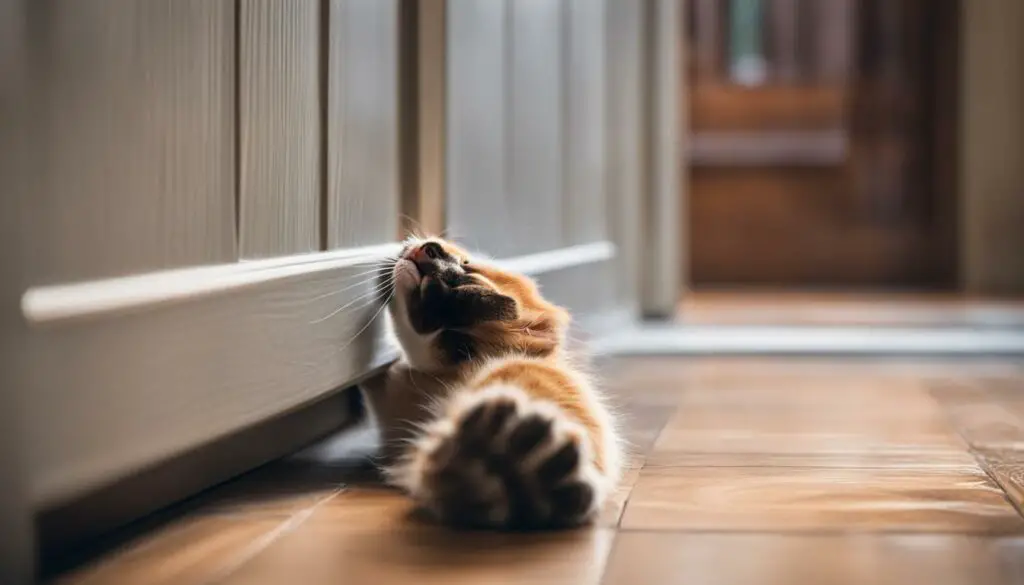Are you tired of your cat invading certain rooms of your home? Whether it’s your home office or the bedroom where you want some peace and quiet, keeping your furry friend out of those spaces can be a challenge. But don’t worry, I’ve got you covered with some simple cat-proofing techniques that can help you reclaim those rooms for yourself.
Key Takeaways:
- Shutting the door or using a small baby gate can be effective physical barriers to keep your cat out of a room.
- Seek the advice of a qualified animal behaviorist or veterinarian to ensure that denying your cat access to a desired room doesn’t increase its stress.
- Distract your cat with toys and treats to safely enter the room and shut the door behind you.
- Make the room uncomfortable for your cat by creating loud noises or blocking off hiding spaces.
- Consider using deterrents and sprays, such as compressed air or unpleasant smells, to discourage your cat from entering the room.
Distract and Securely Enter the Room
Act fast to keep a cat out of a room it wants to enter. Distract the cat with toys and treats to buy yourself enough time to enter the room and shut the door behind you. By making a habit of quickly entering and exiting doors, you can minimize the cat’s opportunities to enter the restricted room. If the cat scratches at the door while you are inside the room, ignore the behavior to discourage it from repeating the action.
- Use interactive toys to engage the cat’s attention and redirect its focus away from the restricted room.
- Keep treats handy to reward the cat for staying away from the restricted area and reinforce positive behavior.
- Create a routine where you swiftly enter and exit the room, making it less tempting for the cat to follow.
In addition to distraction techniques, it’s important to ensure that you enter the room safely. Here are some tips:
- Make sure the door is fully open before entering to avoid accidentally bumping into the cat.
- Be cautious when stepping over any baby gates or barriers that you have set up to prevent the cat from entering the room.
- Close the door behind you quickly to prevent the cat from slipping in while you are occupied.
Remember, consistency is key when implementing these strategies. With time and patience, you can effectively keep your cat out of a specific room while maintaining a harmonious living environment.
“Providing engaging toys and using positive reinforcement techniques can distract and redirect the cat’s attention away from the restricted room.” – Animal Behaviorist
Create Physical Discomfort in the Room
When it comes to keeping your cat out of a specific room, sometimes a physical barrier is not an option. In such cases, you can make the room uncomfortable for your cat, discouraging it from entering. There are a few methods you can try to achieve this.
Loud Noises and Blocked Hiding Spaces
One way to make the room uncomfortable for your cat is by creating loud noises whenever it enters. This can startle the cat and make it associate the room with negative experiences. You can also try blocking off hiding spaces where your cat likes to feel safe. By removing these cozy spots, your cat may be less inclined to enter the room.
Unpleasant Smells
Another method you can use is to introduce smells that cats dislike at the entrance of the room or in areas where the cat usually goes. For example, you can try placing vinegar-soaked cotton balls near the door or in corners of the room. Cats generally find the scent of vinegar unpleasant and may be deterred from entering the room.
It’s important to note that while these methods can be effective in deterring cats from entering a specific room, it’s essential to provide alternative spaces and activities to keep your cat engaged and content.

Use Deterrents and Sprays
When it comes to keeping your cat out of a room, deterrents and sprays can be effective tools. These methods utilize various techniques to discourage the cat from entering the area. One option is to use a canister of compressed air with a motion detector trigger. When the cat approaches the door, the sudden burst of air startles them and deters them from entering. Another option is to try commercial electronic cat deterrents that spray bursts of air when the cat scratches at the door. Additionally, you can use smells that cats dislike, such as vinegar, at the entrance of the room. Cats have a sensitive sense of smell, and these unpleasant scents can discourage them from entering.
It’s important to note that while deterrents and sprays can be effective at keeping cats out of specific rooms, they should be used with caution and in conjunction with other cat-proofing techniques. Some cats may become habituated to the deterrents over time, and they may lose their effectiveness. It’s also important to consider the cat’s well-being and stress levels when implementing these strategies. If a cat is consistently stressed or anxious due to being denied access to a desired room, it may be necessary to seek the advice of a qualified animal behaviorist or veterinarian.
Table: Comparison of Cat Deterrent Methods
| Deterrent Method | Effectiveness | Advantages | Disadvantages |
|---|---|---|---|
| Compressed air canisters with motion detectors | High | – Startles cats effectively – Easy to set up and use |
– Cats may become habituated over time – Requires periodic refills of compressed air |
| Electronic cat deterrents with air sprays | Moderate | – Automates the deterrent process – Can be effective for cats that scratch at doors |
– Can be expensive – May require batteries or power source |
| Smells that cats dislike (e.g., vinegar) | Variable | – Natural and non-intrusive – Can be easily applied |
– Some cats may not be bothered by the smell – Requires regular reapplication |
As with any cat-proofing technique, it’s important to monitor the effectiveness of the deterrents and sprays and make adjustments as needed. Cats may respond differently to various methods, so it may require some trial and error to find the most effective combination for your cat and specific situation. Remember to consider your cat’s individual needs and well-being when implementing these strategies to ensure a safe and stress-free environment.
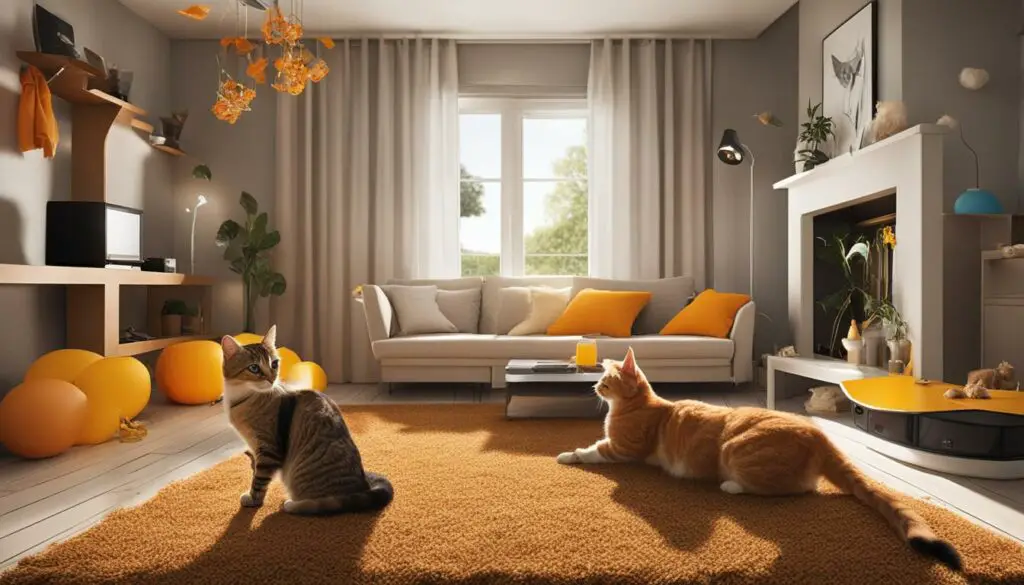
Provide Alternative Entertainment
When it comes to keeping a cat out of a specific room, providing alternative entertainment is a highly effective strategy. By redirecting the cat’s attention and offering enticing options in another room, you can discourage it from trying to enter the restricted area.

In the alternative room, create a cat-friendly environment with multiple comfortable sleeping places, high perches, and engaging toys. Cats love to climb and explore, so providing vertical spaces, such as cat trees, can be especially appealing. Additionally, interactive toys that mimic hunting behaviors, such as wand toys or puzzle feeders, can keep your cat entertained and mentally stimulated.
To further encourage your cat to spend time in the designated area, you can use positive reinforcement training. Scatter extra tasty treats in the alternative room to create a positive association and reward your cat for choosing that space over the restricted room. This will help to redirect its attention and reinforce the idea that the alternative room is a desirable and rewarding place to be.
Remember, it’s important to make the alternative room as appealing as possible to your cat. By creating a comfortable, stimulating, and positive environment, you can effectively stop your cat from trying to enter the restricted room.
Consider Outdoor Cat Enclosures
If you want to keep your cat out of specific rooms indoors, you can consider keeping the cat in an outdoor cattery. This allows the cat to roam outside only on your terms, while providing a safe and secure space. It’s important to ensure the cattery has enough room for the cat to roam, as well as providing perches, hiding places, and mental stimulation. Outdoor cat enclosures should also offer protection from wind, rain, and direct sun.

| Advantages of Outdoor Cat Enclosures | Disadvantages of Outdoor Cat Enclosures |
|---|---|
| Provides a controlled outdoor environment for your cat to enjoy fresh air and exercise. | May not be suitable for all cats, especially those with health conditions or behavior issues that require indoor-only living. |
| Gives your cat the opportunity to explore and experience the natural environment safely. | Requires regular cleaning and maintenance to ensure a hygienic and comfortable living space. |
| Reduces the risk of your cat getting lost or injured outside. | May require additional expenses for building or purchasing a suitable outdoor enclosure. |
By providing an outdoor cat enclosure, you can satisfy your cat’s desire for outdoor experiences while keeping them out of rooms where they are not allowed. This allows you to control their access to certain areas while still providing them with a stimulating and enriching environment. Remember, every cat is different, so it’s important to assess your cat’s needs and preferences before deciding on the best approach to keep them out of specific rooms.
Cat Identification: Microchip and Register Your Cat
When it comes to keeping your cat out of a specific room, one important aspect to consider is cat identification. Before diving into various strategies, it’s crucial to ensure your feline friend is microchipped and registered. Microchipping provides a permanent identification method for your cat, increasing the chances of its safe return if it ever gets lost during the process. This small electronic device, about the size of a grain of rice, is inserted under the cat’s skin and contains a unique identification number.
Microchipping your cat is a simple and safe procedure that can be done by a veterinarian. Once your cat has been microchipped, remember to register the microchip with your contact information. This way, if your cat ends up in a shelter or is found by someone else, the microchip can be scanned, and you can be promptly contacted. It’s essential to keep your contact information up to date, ensuring that you can be reached if your cat is ever found.
Microchipping and registering your cat not only help in case of getting lost but also serve as a valuable precautionary measure. By taking this step, you are providing a layer of security and peace of mind, knowing that your cat’s identification is permanently linked to you. It’s a responsible action that every cat owner should consider, as it can make a significant difference in reuniting with your beloved pet.
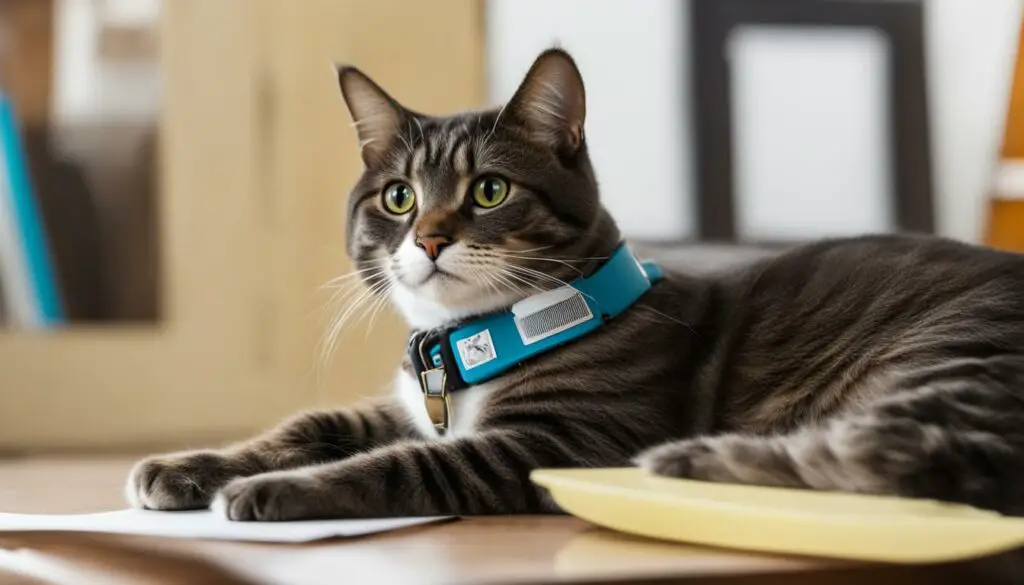
Provide a Safe Room during the Move
During the stressful process of moving with cats, it’s important to provide them with a safe room where they can relax and feel secure. This room will serve as their sanctuary while the rest of the house is being packed and prepared for the move. By creating a safe room, you can minimize the anxiety and confusion that cats may experience during this time.
To set up a safe room, choose a quiet space in your current home where your cat feels comfortable. Make sure the room has all the necessary essentials: a cozy bed, a scratching post, toys, a litter tray, and fresh food and water. Ensure that the room is free from any potential hazards and secure any potential escape routes.
Keeping the door closed and placing a note on the door will alert others to the presence of a cat and prevent accidental escape. Alternatively, if you’re worried about your cat’s safety during the move itself, you can place them in a carrier inside the vehicle. This will help ensure their safety and prevent them from escaping while you’re on the move.
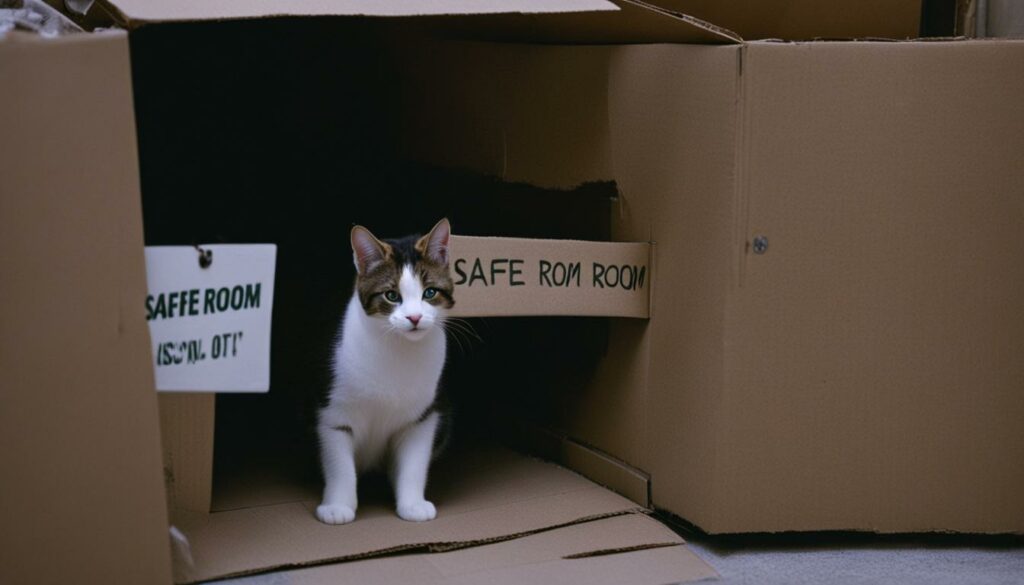
By providing a safe room during the move, you’re creating a familiar and secure space for your cat amidst the chaos of packing and relocating. This will help reduce their stress levels and make the transition smoother for both you and your feline friend.
Set Up a Retreat Room in the New Home
When moving to a new home with your cat, it’s crucial to provide them with a safe and comfortable space where they can retreat and adjust to their new surroundings. Setting up a retreat room allows your cat to feel secure and undisturbed during the transition period. This room should be free from excessive furniture and boxes, allowing for easy exploration.
To create a retreat room, choose a quiet area in your new home, such as a spare bedroom or office. Clear the space of any potential hazards or objects that may cause stress to your cat. Provide essential items like their bed, litter tray, scratching post, and familiar toys. These familiar scents and objects will help your cat feel more at ease.
Keep the door, windows, and other escape routes closed until the move is complete. This prevents your cat from accidentally escaping or becoming overwhelmed by the new environment. Gradually introduce the rest of the home to your cat once everything is in place. Allow them to explore at their own pace, ensuring they always have access to their retreat room until they feel more comfortable in the new space.
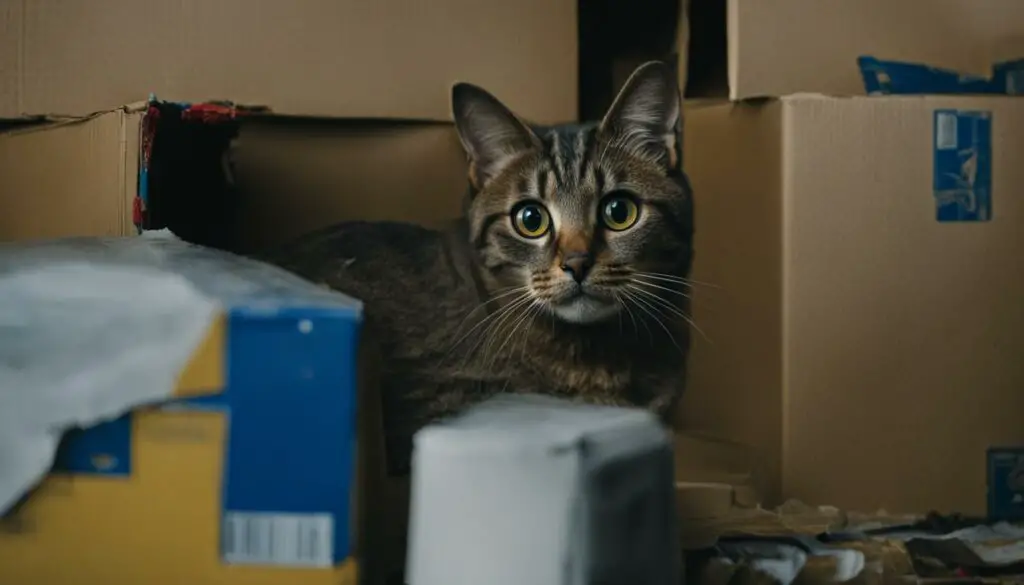
Remember, moving can be a stressful experience for cats, so providing a retreat room in the new home is essential for their well-being. By creating a safe and comforting space, you can help your cat adjust to their new surroundings more smoothly, reducing stress and anxiety during the transition.
Allow Outdoor Access Gradually
If your cat is accustomed to going outdoors and you want to allow outdoor access in the new home, it’s important to do so gradually. Give your cat time to adjust to the new environment before letting it outside. If your cat is particularly territorial, timid, or not yet comfortable in the new home, you may need to delay letting it outdoors for a little longer.
Start by introducing your cat to the outdoors through supervised visits. Use a secure harness and leash, allowing your cat to explore the immediate surroundings under your close supervision. This will help your cat become familiar with the new outdoor environment and establish boundaries.
After a few successful supervised outings, you can gradually increase the duration of outdoor visits. Pay attention to your cat’s behavior and body language during these outings. If your cat shows signs of stress or discomfort, discontinue the outdoor visits and try again later.
Once your cat is comfortable with supervised outdoor visits, you can consider allowing unsupervised access. However, it’s important to provide a secure outdoor enclosure or a cat-proofed backyard to minimize the risks associated with outdoor access. Make sure your cat has access to fresh water, shade, and shelter in the outdoor area.
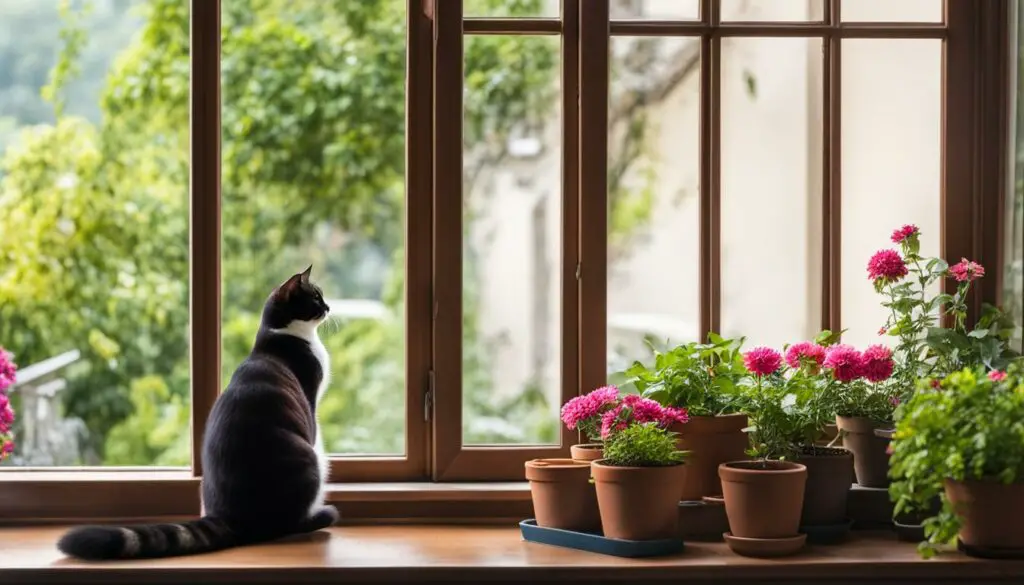
Benefits of Gradual Outdoor Access
- Reduces the risk of your cat getting lost or injured in unfamiliar surroundings
- Gives your cat time to learn the boundaries of the new outdoor area
- Allows you to monitor your cat’s behavior and ensure its safety
- Helps your cat adjust to the new environment and feel more secure
By following these cat-proofing techniques and gradually introducing outdoor access, you can help your cat safely enjoy the outdoor environment in the new home.
Understanding Cat Behavior and Environmental Needs
When it comes to keeping our cats happy and content, it’s crucial to understand their natural behaviors and environmental needs. Cats have instinctual behaviors related to hiding, marking territory, and hunting. By providing the right environment, we can fulfill these needs and reduce destructive behaviors.
Creating a Cat-Friendly Environment
To meet our cat’s environmental needs, we can start by providing hiding places high and low throughout the house. This can include cat trees, shelves, or designated spaces behind furniture. Creating vertical spaces allows cats to feel safe and secure while observing their surroundings.
Another essential aspect is offering appropriate scratching surfaces. Cats have an innate need to scratch, which helps them mark their territory and maintain healthy claws. By providing scratching posts or boards in multiple areas of the home, we can encourage cats to scratch in appropriate places instead of damaging furniture or carpets.
Providing Mental Stimulation
Cats also need mental stimulation to stay happy and engaged. Interactive toys that simulate hunting behaviors can help fulfill this need. Toys that encourage chasing, pouncing, and problem-solving are particularly effective. Rotating toys regularly will keep them interesting and prevent boredom.
Additionally, playtime with our cats is crucial. Spending at least 10 to 15 minutes each day engaging in interactive play can help release their energy and prevent behavioral issues. It’s important to tailor playtime to our cat’s preferences, whether they enjoy chasing a laser pointer or batting at a feather wand.
Creating a Safe and Secure Space
Cats also require a safe and secure space where they can retreat and relax. This can be a designated room or a small corner of a larger room. Equipping this space with a comfortable bed, blankets, and a few favorite toys will create a sanctuary for our cats. Additionally, providing a hiding spot, such as a covered cat bed or a cardboard box with a blanket inside, will help them feel secure.
Understanding our cat’s behavior and environmental needs allows us to create a harmonious home environment. By providing hiding places, appropriate scratching surfaces, mental stimulation, and a safe retreat, we can ensure our cats are happy and thriving. Remember, each cat is unique, so it’s essential to observe their preferences and adjust their environment accordingly.
| Behavioral Needs | Environmental Enrichment |
|---|---|
| Hiding | Provide vertical spaces, cat trees, and hiding spots |
| Marking Territory | Offer appropriate scratching surfaces |
| Hunting | Provide interactive toys that simulate hunting behaviors |
| Mental Stimulation | Engage in interactive playtime and rotate toys regularly |
| Safety and Security | Create a designated safe space with a comfortable bed and hiding spot |
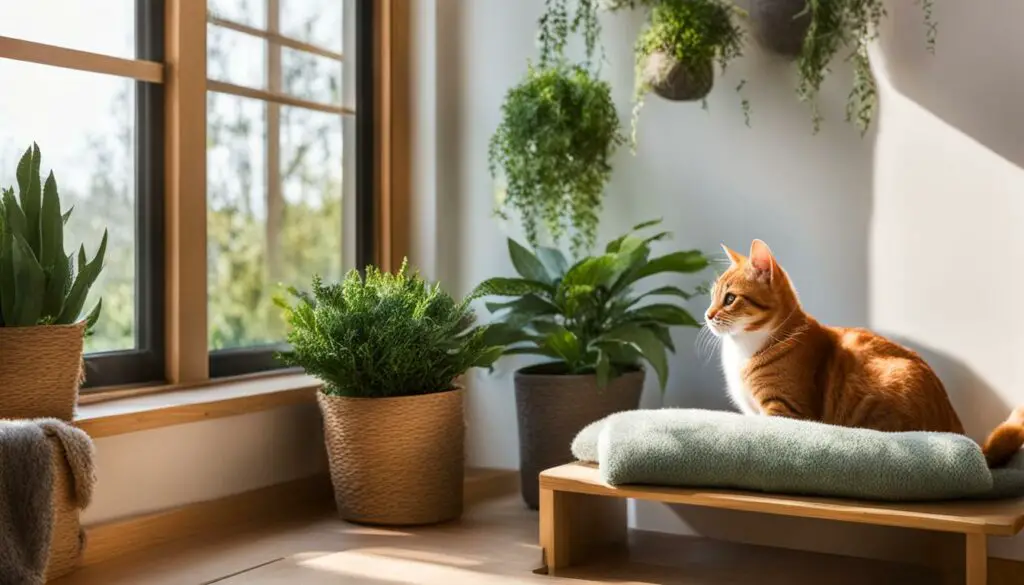
Addressing Litter Box Issues
One common issue that cat owners face is litter box problems. Cats may occasionally urinate or defecate outside of their litter boxes, which can be frustrating and unsanitary. It’s important to address these issues promptly to maintain a clean and healthy living environment for both you and your cat.
When dealing with litter box problems, it’s essential to ensure you have enough litter boxes in your home. The general rule of thumb is to have one litter box per cat plus an additional one. This provides enough options for your cat to choose from and reduces the likelihood of inappropriate elimination. Place the litter boxes in different areas of the house to accommodate your cat’s preferences.
Another consideration when it comes to litter boxes is the style of the box itself. Cats have individual preferences for litter box types, so it’s a good idea to offer a variety of options. Some cats prefer open litter boxes, while others prefer ones with high sides or covered boxes for added privacy. Experiment with different styles to see which one your cat prefers.
If your cat continues to have litter box issues despite having enough available boxes and different styles to choose from, it’s important to consult with a veterinarian. Litter box problems can sometimes be an indication of an underlying medical issue, such as a urinary tract infection or bladder stones. A vet can help rule out any medical causes and provide guidance on how to address the issue effectively.
| Common Causes of Litter Box Problems | Solutions |
|---|---|
| Dirty litter boxes | Regularly clean and scoop the litter boxes to maintain cleanliness |
| Location of the litter boxes | Place the litter boxes in quiet, easily accessible areas where your cat feels safe |
| Stress or anxiety | Provide a calm and enriched environment for your cat, minimizing any potential stressors |
| Litter preferences | Experiment with various types of litter to find the one your cat prefers |
| Medical issues | Consult with a veterinarian to rule out any underlying medical conditions |
Conclusion
In summary, when it comes to keeping your cat out of a specific room, there are a variety of strategies you can employ to cat-proof your home and create a harmonious environment. From simple techniques like shutting the door or using baby gates as physical barriers, to providing alternative entertainment in another room, you have options to keep your cat happy and your desired rooms cat-free.
Additionally, creating physical discomfort in the room by making loud noises or using smells that cats dislike can discourage your cat from entering. Using deterrents and sprays, such as compressed air canisters or cat deterrent sprays, can also help deter your cat from going into restricted areas.
Understanding your cat’s natural behaviors and environmental needs is crucial in preventing unwanted behaviors. By providing hiding places, appropriate scratching surfaces, and interactive toys, you can fulfill these needs and reduce destructive behaviors. Addressing litter box issues and consulting with a veterinarian if problems persist is also important for the overall well-being of your cat.
Remember, the well-being of your cat should always be a priority. If you’re unsure about the best approach or if your cat’s behavior continues to be problematic, seeking the advice of a qualified animal behaviorist or veterinarian is highly recommended. By implementing these cat-proofing strategies, you can create a happy and safe home for both you and your feline companion.
FAQ
What is the most effective strategy to keep a cat out of a room?
The most effective strategy is to shut the door or use a physical barrier like a baby gate.
How can I prevent my cat from entering a room while I go in or out?
Distract the cat with toys and treats to buy yourself enough time to enter the room and shut the door behind you.
What can I do if I cannot physically block the room?
Make the room uncomfortable for the cat by making loud noises or using smells that cats dislike.
Are there any deterrents or sprays that can keep a cat out of a room?
Yes, you can use deterrents like a canister of compressed air or electronic cat deterrents that spray bursts of air.
How can I redirect my cat’s attention to a different room?
Make another room more appealing by offering comfortable sleeping places, high perches, and toys.
What are some strategies for cat-proofing outdoor access?
Consider keeping your cat in an outdoor cattery that provides a safe and secure space to roam.
Why is it important to microchip and register my cat?
Microchipping and registering your cat increases the chances of finding it if it gets lost.
How can I ensure my cat’s safety during a move?
Provide a safe room equipped with the cat’s essentials or place the cat in a carrier inside the vehicle during the move.
How can I help my cat adjust to a new home?
Set up a retreat room where your cat can feel secure and gradually introduce the rest of the home at its own pace.
How long should I wait before letting my cat outdoors in a new home?
Give your cat time to adjust to the new environment before gradually allowing outdoor access.
How can I meet my cat’s natural behaviors and environmental needs?
Provide hiding places, appropriate scratching surfaces, and interactive toys that simulate hunting.
What should I do if my cat has litter box issues?
Ensure you have enough litter boxes in different areas of your home and consult with a veterinarian if problems persist.

